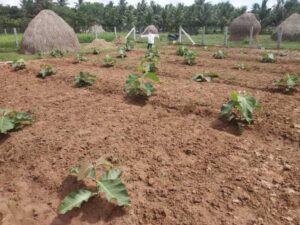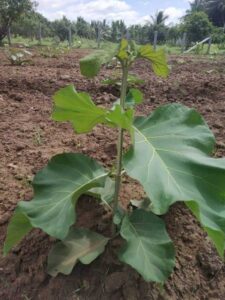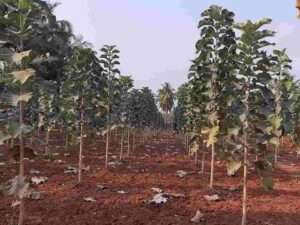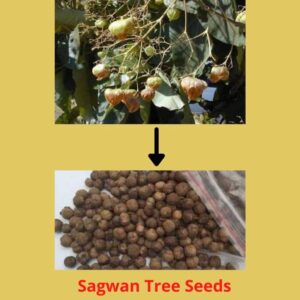Sagwan Tree Farming is in growing trend all over the world as it’s demand is increasing day by day in National and International market. Sagwan is known as Teak in English.
Sagwan Tree
From this growing trend countries like India and Nepal also can’t get untouched for long time.
Sagwan tree is one of the fast growing and tall plant. The growth time of sagwan tree is less. Within the period of 6 months-It can attains the height of (8-10) foot.
There are different factors affecting the success of this plant cultivation, such as:- Seed Quality, Site, Protection From Insects and Method Of Plantation.

Sagwan is a hardwood timber plant that is known for its amazing quality wood. It is known as king of timber. The english name of the tree is Teak. So, The scientific name is Tectona Grandis and In Nepal and India It is known as Sagaun Rukh(सागौन काठ).
Tectona is a genus that contains three species. Out of 3 species- Grandis is more popular and is large in distribution while other two are found in very less area.
This tree is native South Asian countries like India, Srilanka ,Philippines and Myanmar. In world-It is very less found in natural forest. Mainly people grow it as commercial business. Myanmar has large natural teak (Sagwan Tree) forest in world which is controlled by their government.
Sagwan wood is famous for its-Good Timber Quality, Durability, Light weight and Easy to carve quality.
In present situation- Many peoples and companies are growing teak forest as thier business. In Nepal- Teak Farming was established in 1960 at Chiliya in Rupandehi district.
So-Lets learn everything about Sagwan tree farming.
Site Selection
Site selection is crucial step in Sagwan farming. We should choose moist soil receiving good amount of sunlight.
The selected site can be plain or slightly slope. The site should have proper drainage facility. There shouldn’t be accumulation of water in land.
The tree is grown to sell. It’s price depends upon a it’s Timber quality and colour. These qualities come different in different sites. So-Proper site selection should be done.
Soil And pH
Sagwan tree grows well in deep alluvial soil with good drainage facility. Alluvial soil are deposited by water bodies.
The pH of soil good for cultivation is (6.5-7.5). The soil rich in N,P,K and Ca is required.
Especially the soil rich in calcium i.e Calcareous soil is good for Sagwan plantation. Sandy soil is not considered a good soil.
Black colour soil is also good for Sagwan tree. The reason behind this is- Black soil has ability to absorb more water. Whenever- There is water stress to plant- Than it can absorb from that soil.
Climate And Topography
Sagwan tree can be grown in Tropical climate with wet and warm conditions at an altitude of 1200m from sea level.
The annual rainfall required for Sagwan cultivation is (800-2500)mm.
The end temperatures in which we can do Sagwan wood farming is (10-45) degree centigrade.
Light is also another most important factor that determines the growth of the plant. A area receiving good amount of direct sunlight is required for Sagwan tree Farming.
Propagation Of Sagwan Tree
Sagwan farming can be done from both seeds and saplings. Growing from seed takes time while growing from othe techniques like grafting ,cutting and tissue culture are faster way.
We recommend all not to grow the plant from seeds. This takes about 40 years to get good amount of wood.
Instead of seeds- We can buy seedlings that are prepared by the technique of tissue culture.
These tissue culture seedlings are prepared in laboratory. They are genetically improved and performs well in any conditions and are disease resistant.
Tissue cultured seedlings can be identified by following way:-
>>>Take a leaf of seedling and crush it in hand. The colour leaf is red.
We can sow the seeds by direct broadcasting or inline or by making proper layout maintaining the good distance.
Broadcasting is not considered good as there can be many seeds in one place due to which many plants compete for nutrients in one area and thier growth retards.
The line sowing is good for the tree plantation. The distance between the two rows of line is 2 to 4 m.



Nursery Preparation
It is good to make nursery beds to grow seedlings. Seedlings can be made from seeds.
Before establishing nursery-The good site with proper drainage should be made. The area shoud undergo tillage and FYM and insecticide should be mixed in soil.
To prepare seedlings in nursery-Sandy loam soil is considered best. The beds are prepared by earthing up the soil.
The germination percentage of teak seeds is very low(30-50)%. This is due to the strong Dormancy of of teak seed.
For the proper gerimnation of seeds- We should do seed treatment before sowing. The seed treatment requires alternate wetting and drying and the process is explained below:-
To Break Dormancy= Seeds Are Exposed To Alterante Wetting And Drying. The Seeds Are Soaked For 12 hrs And Dried In Sun For 12 Hrs.This Process Is Done For (10-15) Days.
After That It Is sown In Nursery Sandy Loam Soil which germinates within 20-30 days.
Planting Time And Spacing
We can plant Sagwan in the month of monsoon. Rain helps in the fast growth during seedling stage.
The best month for Sagwan plantation is June to August.
We should plant teak by maintaining a distance of (2×2)m or (2.5×2.5)m or (3×3)m. With this spacing we can produce (300-400) plants in 1 Acre of area.
We can also do intercropping with other agricultural crops like ginger and turmeric, chillies, maize, wheat, sesame and various vegetables.
Due to intercropping-The spaces between two Sagwan trees are properly utilized and we can generate some income from that field.
If we do intercropping-The Planting distance of Teak wood increases and reach up to(4×4)m.
Variety Selection
The varities selection should be good because our entire farming is based on it.
Not only seeds- If we are preparing cuttings and Graftings also- We should focus on quality and plus point of that variety.
Some of the best varieties of Sagwan Tree are listed below:-
✓Konni Teak (Sagwan)
✓WestAfrican teak (Sagwan)
✓Godhavari Teak (Sagwan)
✓South and Central American Teak (Sagwan)
✓Nilambur or Malabar Teak (Sagwan)
The Sagwan tree produces seeds which are harvested and are planted in nursery to Produce the seedlings. When, The seedlings are ready to transplant, they are taken to main field. The seeds of this tree look like as shown in image below:-

Land Preparation And Planting
Sagwan plant is planted during June-August (Aasar-Shrawan) I.e In rainy season.
Land preparation should be done one month prior to the plantation i.e in May month. The site should be properly cleaned. The straight lines should be made maintaining proper distance should be done where we dig pit and later plantation is done in those pit.
We should do pit digging in May month. The size of pit should be (30×30×30) cm.
The pit should be left open in sunlight for few days i.e for about 25 days.This will kill all the germs inside the pit
During the plantation time i.e after first rain- We should mix soil with FYM and insecticide and refill the pit.
After refilling the full pit- We should make a hole required to plant the seedling. We take plant the teak seedling with root soil of nursery bed and put in hole of pit. The cover the roots of seedling with soil.
After planting the Sagwan tree seedling-We should properly irrigate the plant. The planting should be done after first rain of monsoon.
Irrigation
We can irrigate the Sagwan plants by two ways:- Traditional irrigation system and drip irrigation system.
After plantation we should irrigate regularly for 1 month.
After 1 month-The frequency of irrigation should be make less and should irrigate in every 3 days. Sagwan should be irrigated during water stress condition only and summer conditions.
There should be the proper facility of drainge. Stagnant of water should be completely avoided.
If too much water is accumulated in surface of the field-Then there may the formation of water blister in plant and fungi may attack.
If we are using drip irrigation system- We should give water in alternate days. Drip irrigation is best for teak plantation.
The problem in drip irrigation system is that- We should frequently check the moisture of soil. Sometimes- The pipes may get blocked and plant cannot get water.
Care And Management
After plantation of Sagwan wood tree- Proper care and management is required during early stage. Later-It grows well with less care also.
We should be weeding of field followed by fertilizer application. Weeds compete with plants for nutrients and water.So-They should be removed.
We can manually remove weeds or we also can use different chemical weedicides.
Fertilizer application should be done everyear. A teak plant requires 35 kg FYM in its total life.
Pruning and thining is another vital operation that should be done time to time in Sagwan cultivation.
Pruning and thining involves the cutting of long branches and othe dense branches and leaves. This reduce competition among tress and girth of wood also increases.
Pruning and thining operation in plant is done at 4th, 8th, 12th, 18th, 26th and 35th years of growth.
While cutting branches- The cut should be clean so that there is no attack of fungi or insects that causes disease.
Another thing we need to look at during Sagwan tree farming is fire. In that area-Sometime natural fire may burn all plants. So-Proper care should be done.
Pest And Diseases
There are not many pests that attack in Sagwan wood. However, There are some. Teak defoliator (Hyblaea puera) and skeletonizer (Eutectona machaeralis) are many pests in Sagwan farming. Skeletonizer can be biologically controlled using the fresh leaves of Calotropis procera, Dautara metal, and Azadirachta indica.
There are some diseases that can cause extensive damage to our plant. Some common diseases in Sagwan Tree and their causes are:-
| Disease | Cause |
|---|---|
| Root Rot | Polyporus Zonalis |
| Canker and Bark Flaking | Fungus |
| Powdery Mildew (Premature Defoliation) | Olivia tectonae and Uncinula tectonae |
Intercropping
Intercropping is the process of growing crops other than our main crop (Sagwan) which have a short lifespan. In sagwan plantation, We can do intercropping in the first two years as the plant doesn’t have much nutrient requirement and there is availability of enough space. After 2 years, Intercropping should be avoided. Some intercropping crops are:- Chilli, Ginger, Turmeric and Sesame.
Harvesting And Selling Price
The Sagwan tree takes about 15 years to produce good amount of quality wood.But- We can get (15-18) cubic ft wood within (10-12) years of plantation.
During cutting of Sagwan- If you want to take harvest again from same tree. Then you should cut the tree from the height of 1 foot above ground. Again within 10 years- we can get good harvest.
The quality of Sagwan wood thus harvested depends on different factors such as:- Colour, Light But Good Strength, Durable, Defence Against Termites And Fungus.
In Nepal the price of per cubic ft of teak plant in Nepal/India is Rs.(3000-4000). Thus within a year of (10-12)- We can earn Rs. (45000-60000) Nepali rupees. You can divide the value by 1.6 for Indian price.
Rules Regarding Sagwan Tree Cultivation
Many people are confused if we need to take permission from Government to start Sagwan Tree Cultivation. Some government has policies of not giving the farming permission of trees which are brought from abroad as they are invasive in nature. For people in Nepal, there is no rule for starting your own private Sagwan tree farming. You can grow the trees in your land and you can sell them whenever you want.
In india, There is certain rules and procedures for harvesting Sagwan Tree:-
First, You need to mark all the trees and assign serial number for each that you are planning to cut down. After preparing report, You need to send it to the regional forestry office. Then – They will check your report and will send an official to check the accuracy of that report. After they give permission, You can harvest the trees.
Opportunities Of Sagwan Farming In Nepal/India
Nepal/India is rich in natural resources and bio-diversity. We can find all kinds of climate in Nepal.
Sagwan tree farming in Nepal/India has great possibilities. Many youths are now involving in Teak cultivation. The demand of wood is increasing in National and International market.
Both governments are also gives priority in Sagwan tree farming. People are also knowing the value of wooden furniture. They have passion for wood. That’s why the future of teak cultivation in Nepal/India has great possibilities.
The price of this wood in Nepali market is Rs. 3000-4000. We can earn in crores by doing Sagwan farming in 1 Acre of land. (Divide by 1.6 For Indian price)
Sagwan farming is in growing trend in Terai region of Nepal. It is also suitable in hills. We have good soil required for teak farming in Nepal.
Uses Of Sagwan Wood
Sagwan tree wood is of great quality and durable. it is used for many puropses. Some of the uses of Teak wood are:-
✓It is used in making doors and windows of houses and buildings.
✓The natural oil present in Sagwan prevents it from attack of insects and fungi. So- It is widely used in making furniture items.
✓It is light weighted and has tensile strength. Thus used to make boats.
✓The leaves of Sagwan plant are used to make plates which are eco-friendly.
Furniture Made From Sagwan Wood


Final Verdict
Sagwan cultivation has great benefits from all side. We can do teak farming and become financially stable within 10 years.
Nepal/India also has great chances of teak farming So- Youths should be involved in this farming and make country strong.
Also Read:-
Pineapple Farming, Cultivation Techniques
Banana Farming: Soil, Variety, Distance And Profit

SIR, does teak wood can be used in flooring in subtitue of marble..
Yes! Teak wood can be used for flooring. But- we don't recommend to use teak flooring in whole house. Instead use- Teak flooring in kitchen. In other place it is better to use marble.
Prakash ji,
I was going through teak cultivation in South Asian region and i came across your article. I am seriously considering giving large scale commercial farming a shot. However, due to time constraint i would prefer to hire experts in this field on project basis?? If you are or you know somebody interested do let me know!!
Hello sir! Teak Farming can be a great idea to make ourself financially successful within very short time. We recommend you to give a start. However, I am not an expert. You can gather information from governmetal forest office. There you might get some expert.